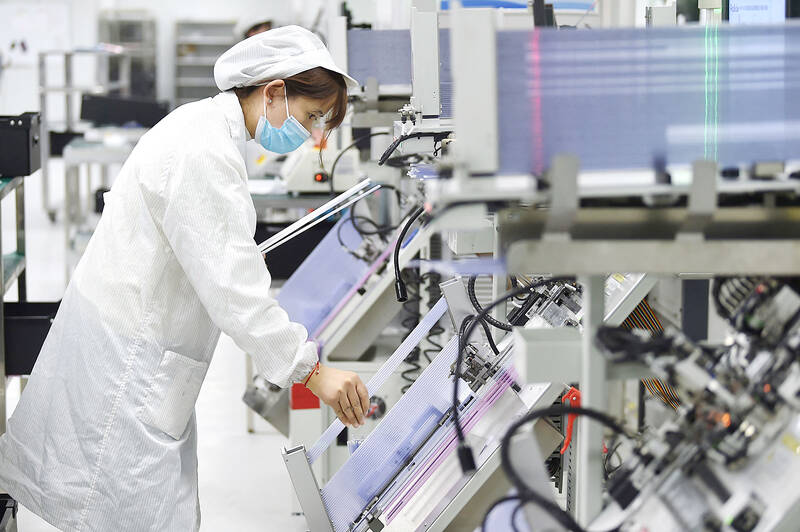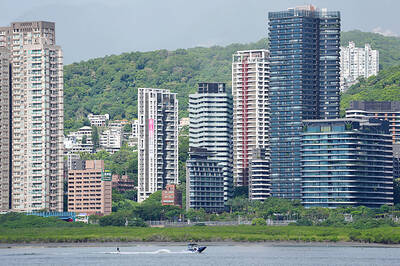China plans to splurge to help its chip sector overcome US export curbs, but money can only do so much unless Chinese firms can break from a cycle that hinders innovation and traps them at the low end of the value chain, industry players said.
The Chinese government has earmarked US$140 billion that could include subsidizing the purchase of domestically produced chipmaking equipment, likely benefiting manufacturers such as China’s sole semiconductor lithography specialist, Shanghai Micro Electronics Equipment Group (SMEE, 上海微電子).
The outlay was in response to the US tightening export restrictions of chipmaking technology for fear it could be used to produce chips for applications such as artificial intelligence, which could be used by the Chinese military.

Photo: REUTERS
However, money alone is not enough to catch Western rivals who are generations ahead. SMEE and local peers mainly sell to domestic chip foundries, and the lack of exposure to advanced chipmaking facilities of the likes of Taiwan Semiconductor Manufacturing Co (台積電) and South Korea’s Samsung Electronics Co has made it difficult for them to independently solve engineering problems and move up the value chain, industry workers and market watchers said.
“This prevents whatever advances they make in R&D [research and development] from getting into mass production, and also limits them from learning more tricks of the trade,” said Mark Li, who tracks China’s chip sector at Bernstein Research.
Just as in the aviation industry, chipmaking equipment manufacturers work closely with clients, offering long-term services including installation, calibration, maintenance and repair of machines that can cost more than US$100 million each.
This collaboration can result in a substantial sharing of know-how that helps both sides advance technologically.
People who worked at SMEE and other Chinese firms in areas such as etching told Reuters how barriers to entry did not seem too high until supply chains became even more global, the engineering more complicated and the market cornered by firms such as Dutch lithography giant ASML Holding NV.
Top management at SMEE — led by a state power firm executive who launched the company in 2002 — had no lithography experience, and staff built their first machines by buying and studying second-hand equipment and by reading public patents and papers, one former SMEE engineer said.
The firm advanced enough to produce a machine that could print circuit patterns as tiny as 90 nanometers on silicon wafers — two decades behind ASML.
Nonetheless, it was hailed as a domestic breakthrough, and in 2018 it won a local government award.
SMEE has not made any major advancements since, in part due to difficulties in procuring equipment from abroad, an engineer said.
“Even if we could have built the machines, we wouldn’t have known how to service and maintain them,” the engineer said.
Another former top employee at a Chinese chipmaking equipment manufacturer recounted how while working to master the etching procedure for 3D NAND flash, the company could not perfect a critical element, namely the channel hole, or hole size.
“We knew what it takes to do that, but we were limited by the equipment’s design capability. Our US rival had already solved that,” the employee said.
Some people in the industry have urged a complete rethink in the way China can catch up by focusing on what the next era of chipmaking could look like rather than compete with overseas peers in trying to make circuits on chips denser and denser.
Late last month, two senior academics from the Chinese Academy of Science published an article advocating a refocus on research and development for new technology and materials, rather than on emulating existing technology from overseas.
Meanwhile, Chinese chip firms have become even more isolated since the US imposed restrictions in October last year that barred US companies such as Lam Research Corp and Applied Materials Inc from supplying equipment that can produce relatively advanced chips without a license.
The situation could be worsened for Chinese companies should Japan and the Netherlands agree to also restrict exports of chipmaking equipment to China.
“When the sanctions came out, all the American companies followed,” an engineer at a Chinese memory chipmaker said.
“When we bought our equipment, we used to get customer service. Now we can’t even get that because of the sanctions,” they said.

RECYCLE: Taiwan would aid manufacturers in refining rare earths from discarded appliances, which would fit the nation’s circular economy goals, minister Kung said Taiwan would work with the US and Japan on a proposed cooperation initiative in response to Beijing’s newly announced rare earth export curbs, Minister of Economic Affairs Kung Ming-hsin (龔明鑫) said yesterday. China last week announced new restrictions requiring companies to obtain export licenses if their products contain more than 0.1 percent of Chinese-origin rare earths by value. US Secretary of the Treasury Scott Bessent on Wednesday responded by saying that Beijing was “unreliable” in its rare earths exports, adding that the US would “neither be commanded, nor controlled” by China, several media outlets reported. Japanese Minister of Finance Katsunobu Kato yesterday also

Taiwan’s rapidly aging population is fueling a sharp increase in homes occupied solely by elderly people, a trend that is reshaping the nation’s housing market and social fabric, real-estate brokers said yesterday. About 850,000 residences were occupied by elderly people in the first quarter, including 655,000 that housed only one resident, the Ministry of the Interior said. The figures have nearly doubled from a decade earlier, Great Home Realty Co (大家房屋) said, as people aged 65 and older now make up 20.8 percent of the population. “The so-called silver tsunami represents more than just a demographic shift — it could fundamentally redefine the

China Airlines Ltd (CAL, 中華航空) said it expects peak season effects in the fourth quarter to continue to boost demand for passenger flights and cargo services, after reporting its second-highest-ever September sales on Monday. The carrier said it posted NT$15.88 billion (US$517 million) in consolidated sales last month, trailing only September last year’s NT$16.01 billion. Last month, CAL generated NT$8.77 billion from its passenger flights and NT$5.37 billion from cargo services, it said. In the first nine months of this year, the carrier posted NT$154.93 billion in cumulative sales, up 2.62 percent from a year earlier, marking the second-highest level for the January-September

‘DRAMATIC AND POSITIVE’: AI growth would be better than it previously forecast and would stay robust even if the Chinese market became inaccessible for customers, it said Taiwan Semiconductor Manufacturing Co (TSMC, 台積電) yesterday raised its full-year revenue growth outlook after posting record profit for last quarter, despite growing market concern about an artificial intelligence (AI) bubble. The company said it expects revenue to expand about 35 percent year-on-year, driven mainly by faster-than-expected demand for leading-edge chips for AI applications. The world’s biggest contract chipmaker in July projected that revenue this year would expand about 30 percent in US dollar terms. The company also slightly hiked its capital expenditure for this year to US$40 billion to US$42 billion, compared with US$38 billion to US$42 billion it set previously. “AI demand actually